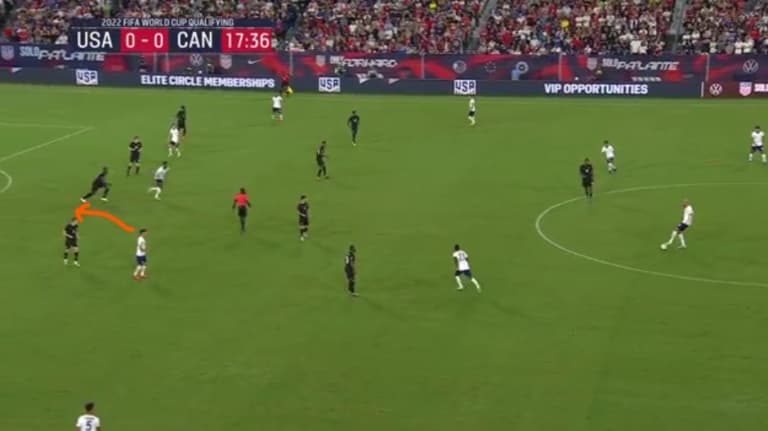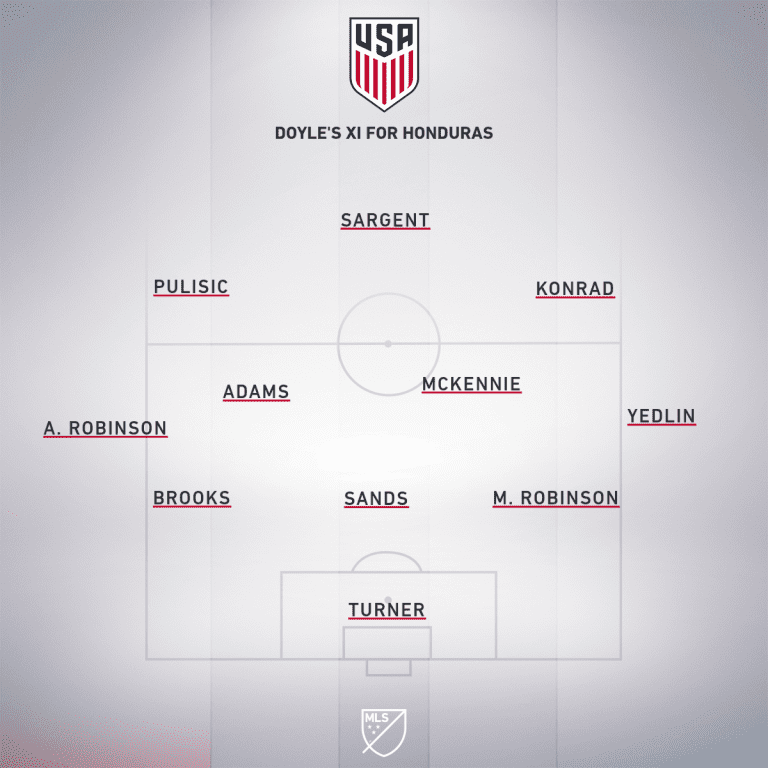"If we don't go out there and do the things we’re good at, we're are just a group of names on a piece of paper."
That’s US men’s national team d-mid Tyler Adams in the wake of their disappointing 1-1 home draw to Canada, a result that leaves the US on just two points through two games. They are not precisely on the precipice, but they are coming close to it and the players know it, as does head coach Gregg Berhalter. They play at Honduras on Wednesday night (10:30 pm ET | Universo, Paramount+), and when that game’s in the books, the US will be more than 20 percent of the way through World Cup qualifying.
We are already at the point where “time is running out” feels like a semi-appropriate sentiment.
And so the US have to figure out exactly what the things that they’re good at are, because through two games it’s pretty tough to pinpoint. Maybe set pieces — they were once again fairly threatening against the Canadians, just as they’d been in the opener down in El Salvador, though I’d argue they squandered a number of chances to be even more threatening — and probably keeping their defensive shape. But it doesn’t feel like much beyond that.
“We need new ideas at times,” said winger Christian Pulisic afterward. “Today we didn’t test them enough. Whether it was not being direct enough or not I’m not too sure, but it just felt like we couldn’t break them down. Obviously they defended well, but we just needed some new solutions and obviously it wasn’t good enough."
It actually was not being direct enough, so Pulisic got that one right. And it definitely was not moving the ball quickly enough to pull Canada’s low-block 5-4-1 from side to side and create the kinds of gaps players like Pulisic and Brenden Aaronson thrive at exploiting.
Pulisic, who is usually not a treasure trove of tactical analysis in his postgame pressers, called that one out, too.
“They defended very deep for most of the game, so it’s natural that we’re swinging the ball around in the back four,” he said. “At times we just couldn’t go from side to side quick enough and make them run enough. I think everything was just a touch too slow today.”
There ended up being a lot of this:
The US do well to create a midfield turnover there, and have a chance to get vertical. When Canada blunt that attack, the US plays backwards and it all just… I won’t use the word “excruciating” but I won’t judge you if you choose to.
From my vantage point, the most frustrating moment of the clip comes in the seconds after the 17:34 mark on the game clock when John Brooks gets on the ball with no Canadian within 15 yards. This is a good outcome for the US! Brooks is an excellent passer, and while the build-up has been slow, it has at least gotten to the point where the guy you want attempting line-breaking passes is in position to hit one.
Center forward Jordan Pefok checks hard to the ball at 17:35. At 17:36 he has dragged Canadian center back Doneil Henry with him, creating a gap for Pulisic to exploit. He can roll into space, a hard run at goal coordinated with Pefok’s hard, direct check. This is how good teams break down bunkered-in opponents
Here, I used some very sophisticated equipment to illustrate what I’m talking about:

Brooks can hit that pass. It’s not a 100% certainty that he’d have dropped it in the bucket, but Pulisic suddenly darting into space like that could’ve — would’ve — put legitimate fear into the Canadian backline. By 17:37, with Pulisic still flat-footed, the moment is gone.
The sequence ends with Brooks and Sebastian Lletget not quite on the same page when Brooks tried to skip a pass and hit a long diagonal.
“We needed much faster ball movement,” Berhalter said. “Everyone could see it, it was just way too long on the ball. It allows Canada to shift. (We’re) not skipping passes, not playing behind them enough. We have to work on that.”
I didn’t have to search for that moment. I literally went back to watch the game, slid the scrubber to what I figured was about 15 or 20 minutes in, and hit play. There were so many static moments like this all night that I knew I’d just randomly bump into one without having to do any work digging for it.
There were other issues at play for the US, mostly centered around the inability to get inside Canada’s midfield shape and make them react to what the US were doing with the ball. At no point did Kellyn Acosta or Lletget make the Canadian midfield uncomfortable, and Acosta, in particular, didn’t really seem to want the ball:
This clip is on the extreme edge of what I’m talking about, but it’s nonetheless of a piece with how the US operated through central midfield on the night. Canada created a no-fly zone and the US took it so seriously that, at times, it didn’t even occur to them to look for the ball when they were in that particular area.
Undergirding this is two things:
- The US lack a dynamic central midfield ball-carrier who is good in traffic, can eliminate opposing defenders off the dribble and put pressure on the opponent’s entire shape in doing so. Acosta has been excellent as a No. 6, but as a No. 8 he too often drifts (save for occasional transition moments), while Lletget is much more of a cog who can help turn advantages into chances rather than the type to break things down himself, and...
- Canada are absolutely terrifying on the counter.
There was strong "god, I hope I don't make a mistake" energy on the ball from a lot of US players, and I get it. Alphonso Davies is one of the few players in the world who can make DeAndre Yedlin look slow, and Cyle Larin is a Champions League center forward in his prime. Turnovers or a moment of inattentiveness can turn into goals in the blink of an eye, and that’s exactly happened:
(Why did Brooks just stop running???)
But the fear of those quick transitions and the inability to get inside Canada’s midfield shape and force them into uncomfortable spots made the US too tentative. They rarely forced Canada’s midfielders or defenders to commit, and if you don't force the opposing defenders to commit, you don't break their shape. If you don't break their shape, then the passes you're hitting are riskier. If you know the passes you're hitting are riskier and more likely to result in turnovers, then you're going to be even more tentative.
It became a vicious cycle. And so even though the US had 72 percent possession, I think it’s fair to say that Canada set the stakes for how the game would be played, and certainly they executed their gameplan better than the US did by a pretty decent margin.
If you want a few silver linings, I’ve got them for you here:
- Davies is the best player in the region, and at the moment I don’t think anyone else is all that close. Larin, meanwhile, is probably the best center forward in the region (even though he often plays as a target winger for Besiktas, he’s still very much a center forward). It took $100 million of attacking talent to break the US backline down, and the only other time they'll face anything close to that in the Ocho is if/when they play a full-strength Mexico.
- Whenever the US pressed and actually won second balls in midfield, they caused fires. I just wrote a whole bunch about tactics, but “up the intensity level, don’t play scared and make them feel you” is probably the first piece of advice I’d give to this US team after this game, and ahead of Wednesday’s trip to Honduras.
- The US are an incredibly young team, filled with players who have mostly not taken part in World Cup qualifiers before. It stands to reason as this event progresses, the kids will acclimate and play better (I think we’ve already seen that with the likes of Aaronson and Antonee Robinson, while Miles Robinson and Adams have been monumental through 180 minutes).
The US are not yet in must-win territory, but three points at San Pedro Sula would go a long way toward calming some frayed nerves that are apparent both in the squad and especially in the fanbase. Berhalter has to get more things right than he has thus far managed to in terms of squad rotation, and the players simply need to execute better. They left points on the board at El Salvador with shoddy finishing, and then against Canada they left the door open and lost their heads after taking a hard-earned 1-0 lead.
They have looked somewhat overawed by the moment. That has to end.
Here's my guess at the XI:
Editor's note: This lineup was published before Monday's news that Sergino Dest has been diagnosed with a right ankle sprain and will not be available for selection, while midfielder Weston McKennie will not travel to Honduras and is returning to Italy following a violation of team policy.

Some notes
• Weston McKennie, who earned himself a suspension on Sunday night for breaking team Covid protocols (which he also did with Juventus back in April; what a fun guy!), might or might not be available for this game. Berhalter said it’s yet to be decided.
• Gio Reyna is out with a hamstring strain, while Sergino Dest had to be subbed just before halftime on Sunday with what has been reported as an ankle sprain. I’m assuming Dest will be unavailable.
• Berhalter said there could be additions to the US squad, but there's no indication yet as to who it could be. Certainly some depth at right back could be useful given how leggy Yedlin looked at the end of the Canada game.
• You’ll notice I’ve got the US in a 3-4-2-1 rather than the 4-3-3 they’ve used through two games. In part that’s just extra coverage for tired legs (Adams, Yedlin and the Robinsons), but it’s also partially a tactical shift given that Honduras tend to use two forwards.
• You could talk me into Pefok or even young Ricardo Pepi over Josh Sargent up top. I am agnostic on the forward situation.
• The recipe against Honduras is the same as it's always been: transition moments and set pieces.













